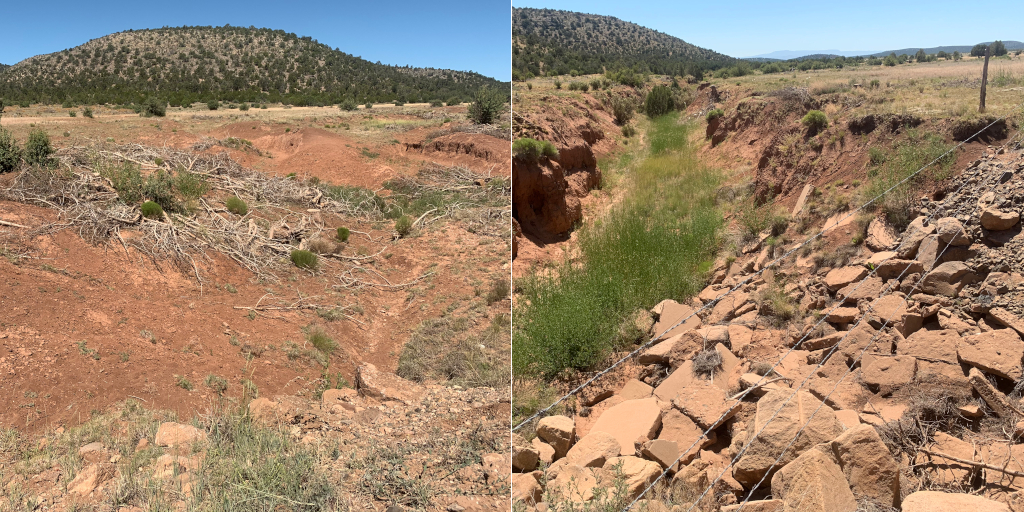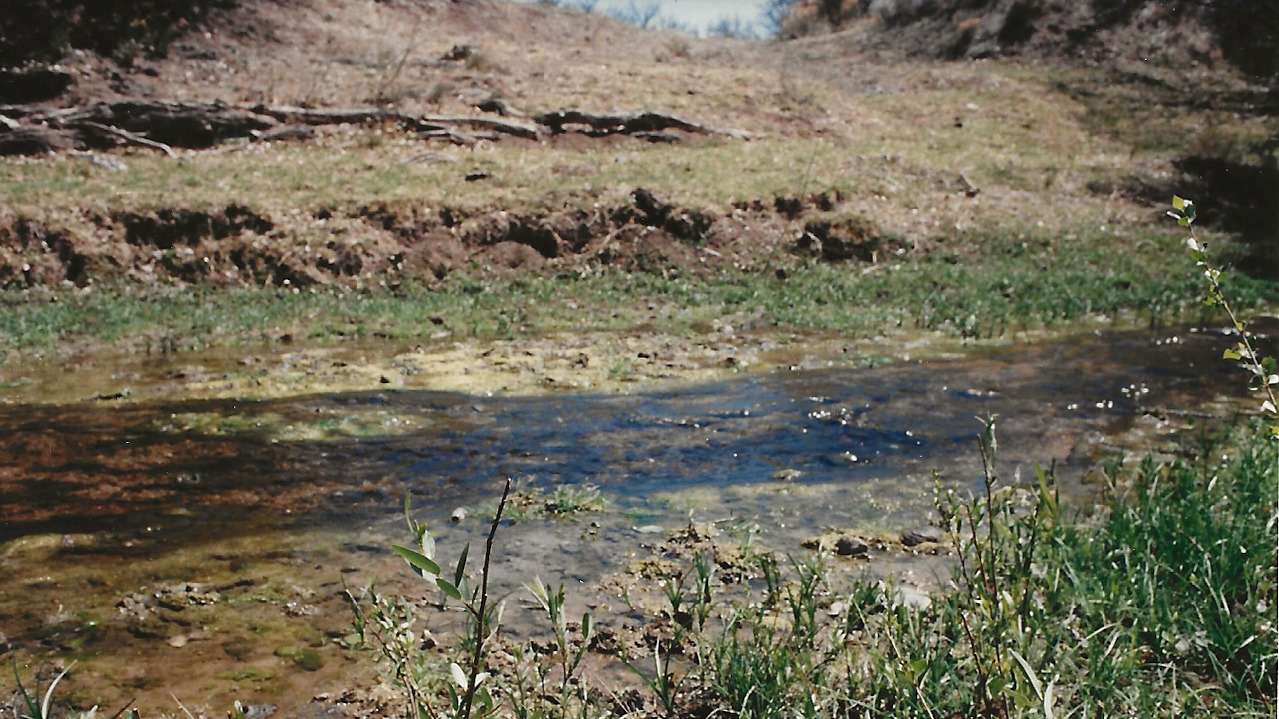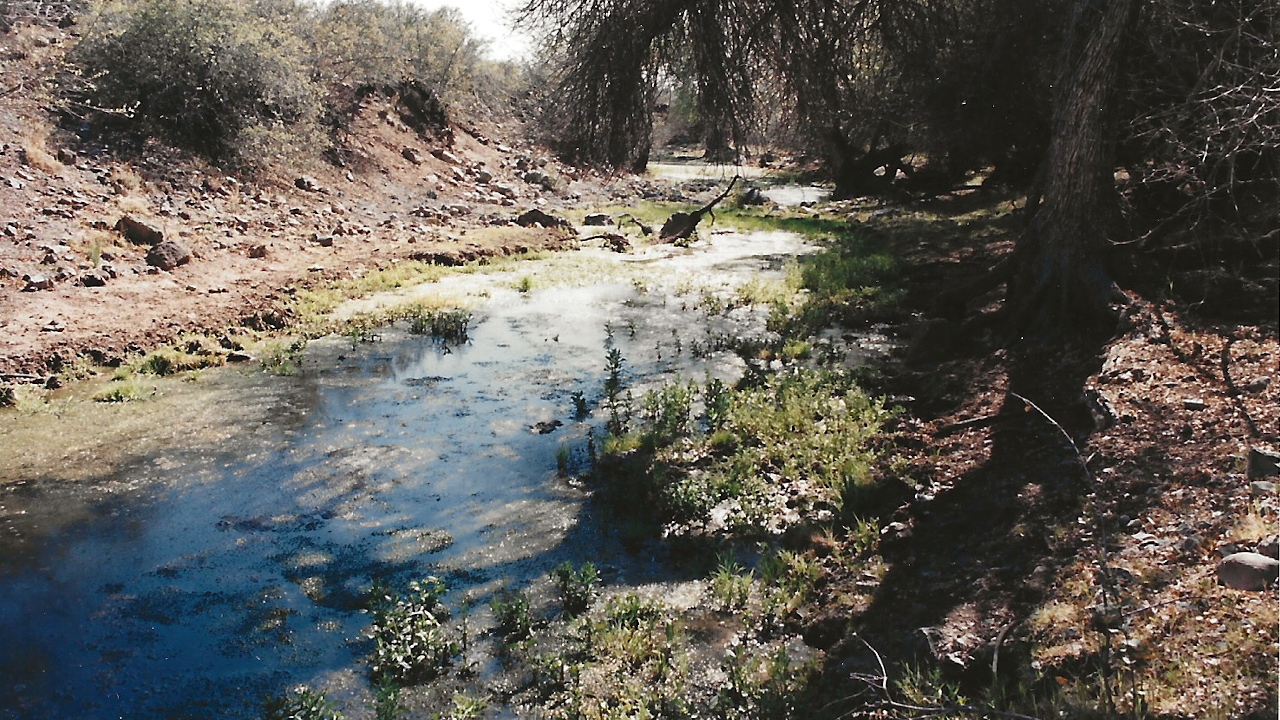Holistic resource management (HRM) proponents often claim that HRM livestock grazing schemes are a form of regenerative agriculture, but they are degenerative in arid environments.
HRM was invented by Allan Savory, who has convinced many people that he is an environmental guru. His followers in Arizona are led by the Drylands Alliance for Addressing Water Needs (DAAWN). Savory claims that disturbances caused by livestock grazing are natural because vegetation co-evolved with herds of wild grazing animals. But that’s not true for the rugged rangelands of the American Southwest. Big herds of large grazing animals, such as bison, haven’t been found here since at least the end of the Pleistocene era, more than 10,000 years ago – because the climate was too arid to support them. Subsequently, the area’s dry ecosystems aren’t adapted to intense grazing from large ungulates.
Despite this, HRM proponents still claim that Savory’s grazing systems are a way to produce win-win solutions, wherein ranchers get to put more cattle on the land while, at the same time, wildlife habitat is improved by the their grazing. HRM grazing schemes are typically implemented through a coercive and biased “collaborative” process, and use high forage utilization rates combined with short duration, time-controlled, periods of grazing. The problem is that HRM grazing schemes aren’t based on science, and there’s plenty of research that proves they don’t work.
Moreover, numerous HRM grazing projects in Arizona have disappointed.
Prescott National Forest
The Prescott National Forest was one of the first public land management agencies in Arizona to authorize HRM schemes on the grazing allotments it manages.
Orme Ranch – It started in 1984 when an HRM grazing scheme was proposed by Alan Kessler, manager of the Orme Ranch, which holds the permit for the Forest’s V-Bar grazing allotment. (Note: Enoch Malouff took over the management of the Orme Ranch in 2014, and has also used HRM grazing schemes.) The NEPA public planning process was subsequently engaged, and two public scoping sessions were conducted which identified multiple issues. Then in December, the Prescott National Forest Supervisor approved the completion of an environmental assessment (EA) for the project that would only compare the existing grazing scheme with the proposed HRM scheme – no analysis of an improved conventional grazing alternative would be included. This was a violation of NEPA regulations, which require the analysis of a reasonable variety project alternatives.
A decision notice was subsequently issued in November 1985 to implement a new allotment management plan (AMP) for the V-Bar allotment. The accompanying EA included a list of the possible negative implications the HRM grazing scheme would have upon the local wildlife, and the AMP recognized that HRM schemes were unproven, so it called for extensive follow up monitoring, and required that a backup plan would be implemented within 30 days if the HRM plan failed to meet its objectives.
The Forest scheduled the V-Bar allotment for a new NEPA analysis in 2003, which would have provided the public with documentation of the efficacy of the HRM grazing scheme. But that never happened. Instead, a decision memo was issued in September 2007 to reauthorize the HRM scheme. It didn’t mention the results of the extensive monitoring required by the 1985 EA, but just stated that, “In general species composition on the allotment is near potential and has exhibited good vigor and health.” (Section 339 of the 2005 Consolidated Appropriations Act allowed the Forest Service to reauthorize grazing on allotments without completing a NEPA analysis for federal fiscal years 2005-2007.)
A new AMP for the V-Bar allotment was subsequently completed in July 2009. It also glossed over the issue of the HRM monitoring data. It did, however, reference the Forest’s forage utilization guidelines, which limited growing season grazing to no more than 35% of upland forage use, and dormant season use to no more than 50%. But it also included some scientifically unjustified exceptions to these guidelines to accommodate the HRM scheme. It said that dormant season grazing could be allowed to exceed 50% “but no detriment to plants will be allowed.” And it was unclear if the 35% growing season use limit was for the entire year, as the guidelines intended. This is an issue because the allotment’s annual operating instructions (AOIs) show that the allotment’s pastures are often grazed multiple times a year.
Forest Service decision memos don’t require a NEPA analysis, so the public didn’t have an opportunity to review whatever monitoring data that might have been gathered, or to submit comments, or file an objection to the decision.
The photos below document the riparian habitat degradation caused by the HRM grazing scheme used on the V-Bar allotment.
Chino Winds NRCD HRM Demonstration Project – In the early 1990s the Arizona Department of Environmental Quality (ADEQ) convinced the U.S. Environmental Protection Agency (EPA) to approve a project that awarded a couple of Section 319 nonpoint source (NPS) water pollution prevention grants totaling $175,600 to help fund the Chino Winds Natural Resource Conservation District HRM Demonstration Project on the Yavapai Ranch, which includes the Prescott National Forest’s Yavapai grazing allotment. A coordinated resource management plan (CRMP) was used to implement an HRM grazing system that was supposed to increase ground cover, and thereby reduce erosion and NPS water pollution. The project monitoring showed the CRMP didn’t produce the expected results.

Upper Verde River Adaptive Management Partnership (UVRAMP) – In 2000 ADEQ took over the administration of EPA Section 319 NPS water pollution prevention grants in Arizona. It was renamed the Water Quality Improvement Grant (WQIG) program. ADEQ, however, had apparently failed to learn from the previous Section 319 HRM project failures in Arizona, because in 2002 they awarded the $55,700 WQIG #4-012 to EcoResults! to implement some HRM livestock management measures on the Prescott National Forest’s Del Rio/West Bear and Horseshoe grazing allotments, located along the upper Verde River. The permittees of the two allotments had signed a memo of understanding (MOU) in 1998 with the U.S. Forest Service to become part of the UVRAMP. The stated purpose of the UVRAMP was to foster collaboration to address, “the cumulative needs of all parties as it pertains to management of the Upper Verde River Ecosystem.” The WQIG grant was used to help fund a project that was supposed to include “state-of-the-art” techniques, but most of them were common measures, such as building fences, and cutting down juniper trees to grow more grass for cattle. The project’s uniquely HRM measure of having cattle stomp hay and seeds into the ground to improve the odds of germination didn’t work. This strategy was used even though previous research (Winkle 1991) had shown that the primary factor for seed germination on arid lands is the timing and amount of precipitation.
HRM Projects in Other Locations
Red Hill Demonstration Grazing Allotment – In 1983 the Bar T Bar Ranch convinced the Coconino National Forest to allow them to set up an experimental HRM grazing system on their Red Hill grazing allotment. (The allotment was subsequently consolidated with several adjacent allotments into the current Bar T Bar allotment.) The area was grazed using HRM strategies from 1985 through 1989, and afterwards the Arizona Game & Fish Department published a report on the experiment in 1990 titled Effects of a Savory Grazing Method on Big Game. It assessed the results of the Red Hill HRM project and concluded that:
“From a land management standpoint this particular HRM application could not be considered successful. Excessive number of livestock in conjunction with adverse climate conditions initiated a decline in range condition. Livestock numbers were eventually reduced to zero on the cell.
There’s nothing within the overall results of this study to suggest suggest that a doubling, or near doubling, of original stocking rates is advisable under HRM.”
HRM Dodson Pilot Project – In 1990 the Apache-Sitgreaves National Forest published a summary of the HRM mulit-year pilot project that was conducted with Allan Savory’s guidance on the forest’s Dodson grazing allotment. The report concluded it had failed because the project team had “not practiced” HRM properly. (This excuse is often used when HRM projects fail.)
Greenback Holistic Resource Management Unit – Arizona’s Tonto National Forest published a study in 1991, wherein it showed that the implementation of HRM along Greenback Creek, on the Boneyback grazing allotment, failed to improve the condition of the stream’s riparian habitat. The Boneyback permittee eventually decided to abandon HRM and implemented a conventional deferred rotation plan.
Arizona Bureau of Land Management (BLM) HRM Seminar – In 1994 the Arizona BLM state office spent thousands hosting an HRM seminar taught by Allan Savory that proved to be of no use.
Pratt Allotment Demonstration of Ungulate Action – In 1995 the ADEQ convinced the EPA to award another Section 319 grant of $79,800 to help fund another HRM demonstration project on public land on the BLM Pratt Tank grazing allotment on the arid Arizona Strip. It was supposed to show that feeding a herd of 400 cattle confined to a relatively small pasture of sagebrush would kill the sagebrush and increase the ground cover, especially grass, thereby reducing erosion and NPS water pollution. It, of course, didn’t produce the expected results.
High Lonesome Ranch HRM Learning Center – In 1997 the BLM Safford Field Office approved a proposal by Jim Deal, the permittee for the BLM’s High Lonesome grazing allotment, to implement an HRM grazing plan on the allotment, and with the help of Allan Savory, use his ranch as an HRM learning center. The HRM scheme didn’t produce the expected results, and Deal sold the ranch and moved to Tennessee.
HRM Livestock Management Uses Junk Science
HRM proponents like to avoid scientific discussions. For instance, they compare HRM’s intensive grazing schemes to situations where there was previously little or no grazing management, taking advantage of the fact that something is better than nothing – but avoiding a direct comparison with science-based livestock management.
They also hijack the debate by trying to focus it on irrelevant topics. Their argument that grazing can improve soil nutrients is a good example. The lack of soil nutrients isn’t the primary limiting factor for vegetation in the arid West, it’s the lack of rain, and rain doesn’t follow the hoof.
In fact, HRM proponents go so far as to completely ignore science. For example, research has shown that livestock grazing actually decreases organic matter in the soil of the West’s arid ecosystems. This makes common sense, because large amounts of organic matter are removed from the land when cattle are rounded up and sent to markets.
The proponents also like to claim that cattle hoof action is good for the soil because it compacts it, so that it doesn’t get washed away. There’s plenty of research, however, that shows soil compaction by cattle is a bad thing, because it prevents rain from infiltrating the ground and thus increases runoff and erosion downstream. At other times they claim that hoof action is good because it chops up the soil, which gives seeds places to germinate. But pulverized soil also increases runoff and erosion, and seed germination in the Southwest, as mentioned above, is primarily dependent upon timely precipitation.
HRM advocates like to call it time-controlled grazing because they claim that how long cattle graze is more important than how much they graze. But research (Galt 1999) has shown high forage utilization rates, like those used in HRM schemes, reduce forage production – even when plants are grazed when they are dormant in the winter. They also claim that high forage utilization rates are good because plants are stimulated to regrow when they’re grazed. Like a lot of HRM nonsense, it might sound good, but it’s not true in arid environments where plants grow mostly in response to the infrequent precipitation. It’s often been said, for example, that Arizona, like much of the arid West, is a land of perpetual drought, interrupted by an occasional wet year. The vegetation, along with the wildlife that depend upon it, have to survive the dry years so they can take advantage of the infrequent wet ones. This means livestock numbers must be modest enough to ensure conservative forage utilization rates. As one Forest Service range conservationist pointed out to me, “What happens if it doesn’t rain?” And the Southwest has been experiencing a nearly uninterrupted drought for the last 20 years.
Another problem with time-controlled grazing is that a myriad of fences are typically built to create small pastures, called paddocks by HRM devotees, in order to promote the high-intensity grazing. But barbed wire fences can kill or injure wildlife, and also disrupt their normal movements. And the portable electric fences that HRM devotees like to use can kill small animals, like birds and lizards.
The HRM strategy of using livestock grazing to stimulate plant growth includes denigrating old plant growth by labeling it “decadent.” HRM advocates complain that dead plant material hinders new vegetative growth that cattle prefer to eat by blocking sunlight. But old plant growth adds to ground cover, which helps to prevent erosion, and also provides essential habitat, food and shelter for a variety of living things. Moreover, life-giving shade is found beneath old growth in the desert Southwest.
The lengths some HRM advocates will go to defend their junk science is shown by their claim that it helps to prevent wildfires. It’s true that heavily grazed areas are less likely to burn because there’s little vegetation. But they fail to acknowledge the fact that periodic, low intensity fires are natural ecosystem disturbances that help to maintain grasslands by controlling the spread of woody vegetation that can fuel more intense fires. High intensity grazing, like the kind used in HRM grazing schemes, removes the herbaceous vegetation needed to carry these types of fires. As another Forest Service range con once told me, “HRM is very good at growing brush.”
Savory’s most outrageous claim, however, is that HRM grazing schemes can help fight climate change by capturing atmospheric carbon. This nonsense prompted the Sierra Club to issue an official statement in 2013 to scientifically refute it
That’s the situation regarding the uplands. There’s no justification for allowing any type of livestock grazing in riparian areas – using HRM or any other scheme. In fact, the ecological disturbances caused by cattle grazing desert in riparian areas can help spread invasive exotic tamarisk trees along streambanks.
But despite all of the science proving HRM schemes don’t work, the Republican-controlled Arizona Legislature passed a law in 1995, HB 2274, that created an HRM program for the Arizona State Land Department. The bill, sponsored by Rep. Russell Bowers, R-Mesa, gave the agency the option to facilitate HRM plans in order to “alleviate the need for critical habitat designations” under the U.S. Endangered Species Act. According to agency officials, none have been completed, although that doesn’t mean much, because the Land Department conducts almost no monitoring of livestock management on the state land it leases for grazing. The only information they regularly gather from their lessees comes from the short grazing questionnaires they ask them to complete annually.
Most importantly, HRM grazing schemes are inappropriate for our public lands because they are solely focused on livestock forage production. This violates the multiple use doctrine under which the various uses of our public lands are supposed to be managed in a combination that best serves the public interest. Dedicating these lands to agricultural production at the expense of all other uses violates this law. And considering the fact that HRM schemes don’t work, this means that the Forest Service and Bureau of Land Management should not be allowed to authorize their use on the public land grazing allotments they administer.
Updates
In March 2023 the Prescott National Forest’s Verde Ranger District completed another new AMP for the V-Bar grazing allotment without a NEPA analysis. The HRM grazing scheme was reauthorized.



